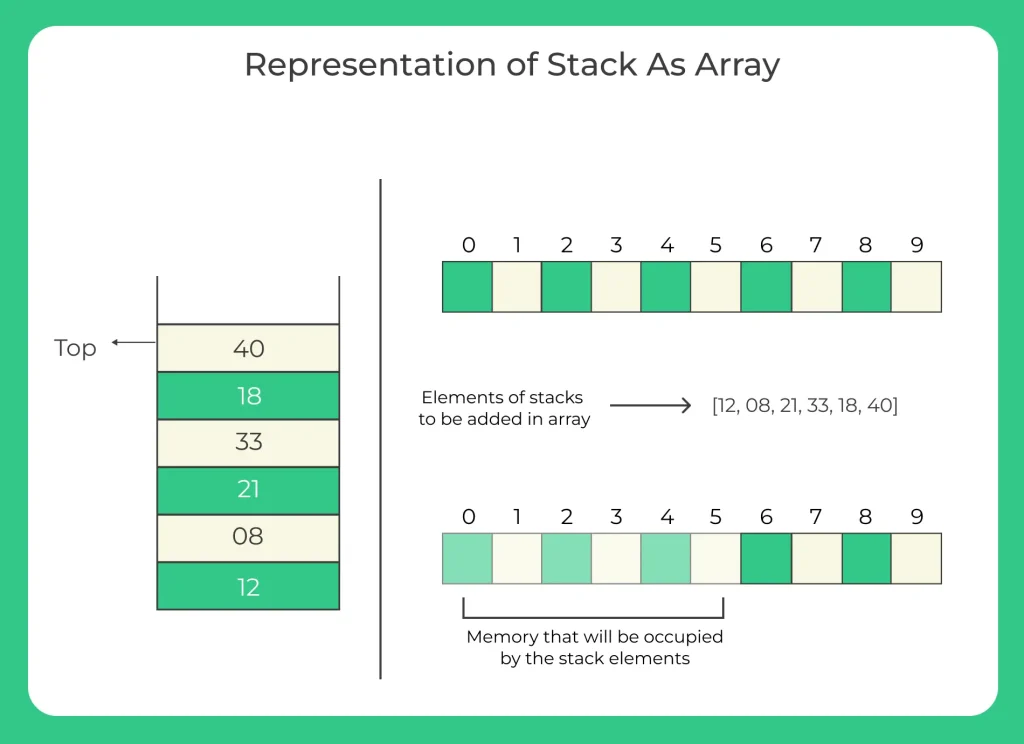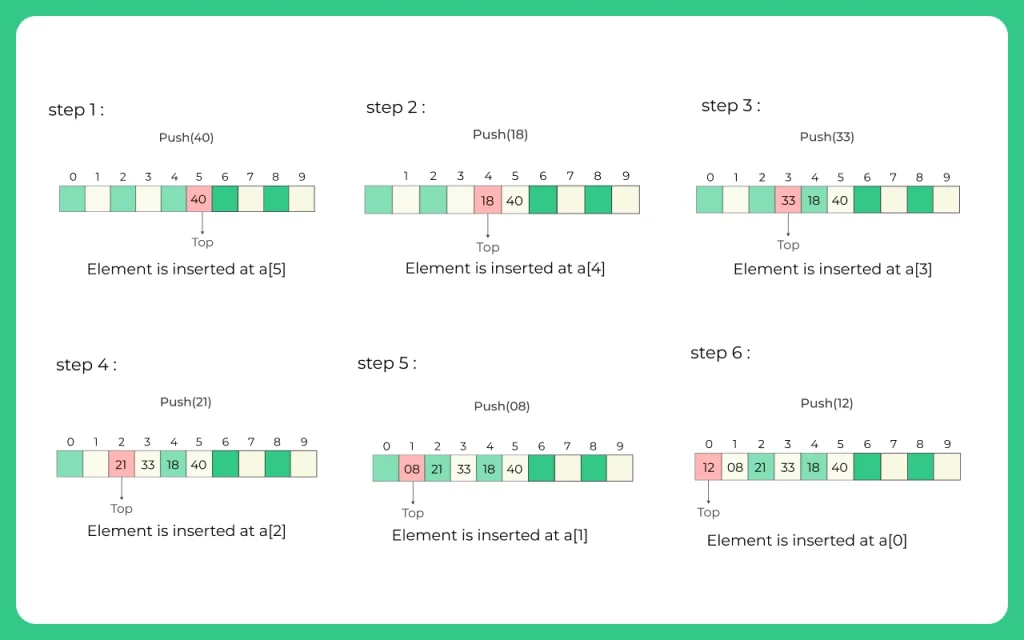Representation of a Stack using Array | C++ Solution
Representation of Stack using an array in C++
Representation of a Stack using Array – Stack is one of the most important linear data structures, that we can use in different algorithms or implement the application in various problem solving. A stack is a linear data structure, that means it can be easily implememented using an array.
You can use array to store some elements in the specific order you recieve them. Then you can use simple easy techniques to manage the data so that it can work like an Stack. Here we will go through the Representation of a Stack using Array.

What is Stack in Cpp?
Stack is a data structure where you can add any kind of and store then in a LIFO (last in first out) manner. To know more about Stack in C++ STL : Stack in C++ STL
- First, you push 2, 3, and 4 into the stack, so 4 goes on top.
- The stack now looks like this (from bottom to top): [2, 3, 4].
- When you pop, the top value 4 is removed — since stack works on Last In First Out (LIFO).
- Now, the top of the stack becomes 3, which was pushed just before 4.
- So, after popping once, 3 is the current top element of the stack.
Representation using an Array
There are some major differences between a stack and an array. like,
- Array size is fixed, but the same isn’t applied for stack.
- Also, in a stack you can only pop or push values only from or in the last element
Now let us focus on how we can implement a stack using an array.
For Example:
We are given a stack of elements: 12 , 08 , 21 , 33 , 18 , 40.



Prime Course Trailer
Related Banners
Get PrepInsta Prime & get Access to all 200+ courses offered by PrepInsta in One Subscription
Code for Stack in C++ (using Class)
A stack is a linear data structure that works on the Last In First Out (LIFO) principle. Using a class in C++, a stack can be implemented with a fixed-size array and a top variable to track the top element’s index.
- This class includes basic stack operations like push() to insert elements, pop() to remove the top element, peek() to view the top, and isEmpty() to check if the stack is empty.
- This implementation is simple and efficient for cases where the maximum size is known and fixed in advance.
Code in C++:
// Cpp Program for Implmentation of stack (array) using structure
#include<bits/stdc++.h>
using namespace std;
class Stack
{
public:
int top;
int maxSize;
int* array;
Stack(int max)
{
top=-1;
maxSize=max;
array=new int[max];
}
int isFull()
{
if(top==maxSize-1)
cout<<"Will not be able to push maxSize reached"<<endl;
return top==maxSize-1;
}
int isEmpty()
{
if(top==-1)
cout<<"Will not be able to pop minSize reached"<<endl;
return top==-1;
}
void push(int item)
{
if(isFull()) return;
array[++top]=item;
cout<<"We have pushed "<<item<<" to stack"<<endl;
}
int pop()
{
if(isEmpty()) return INT_MIN;
return array[top--];
}
int peek()
{
if(isEmpty()) return INT_MIN;
return array[top];
}
};
int main()
{
Stack stack(10);
stack.push(5);
stack.push(10);
stack.push(15);
int flag=1;
while(flag)
{
if(!stack.isEmpty())
cout<<"We have popped "<< stack.pop()<<" from stack"<<endl;
else
cout<<"Can't Pop stack must be empty\n";
flag=0;
}
}Output:
We have pushed 5 to stack We have pushed 10 to stack We have pushed 15 to stack We have popped 15 from the stack
Time and Space Complexity for Stack Implementation
| Operation | Time Complexity | Space Complexity |
|---|---|---|
| isEmpty() | O(1) | O(1) |
| push() | O(1) | O(n)(for array of size n) |
| pop() | O(1) | O(1) |
| peek() | O(1) | O(1) |
To wrap it up:
The program demonstrates how a stack can be represented using arrays in C++, showing how simple operations like push, pop, and peek can be performed effectively. It helps in understanding the internal working of stack operations and how memory is managed within a fixed-size array.
Though this method is easy to implement, it has certain drawbacks like limited size and the possibility of overflow when the array becomes full. Still, it forms the foundation for implementing more advanced stack structures using dynamic memory or linked lists later on.
FAQs - Stack implementation using Linked List in C++
The primary limitation is that the size of the stack must be predefined (#define MAX) and cannot grow dynamically. If the number of push operations exceeds this size, it leads to stack overflow. Additionally, resizing arrays at runtime is expensive compared to dynamic memory allocation used in linked list implementation.
To handle memory dynamically, you can replace the fixed-size array with a dynamically allocated array using new and resize it using techniques like doubling the array size when full (similar to dynamic array or vector behavior). You must also manage memory deallocation to prevent leaks.
Yes, two stacks can be implemented in a single array from opposite ends. One grows from the start, and the other from the end. This ensures maximum utilization of space until they collide. This method prevents space wastage that happens when one stack fills up while the other remains empty.
The time complexity of overflow check is O(1) because it involves a single comparison: whether top >= MAX – 1. It doesn’t depend on the number of elements in the stack, making it efficient and predictable in runtime.
In production-grade code, instead of printing messages, you should use exceptions. Throw a custom exception (e.g., StackOverflowException or StackUnderflowException) when an invalid operation is attempted. This approach follows better coding practices and allows higher-level logic to handle the error appropriately.
Get over 200+ course One Subscription
Courses like AI/ML, Cloud Computing, Ethical Hacking, C, C++, Java, Python, DSA (All Languages), Competitive Coding (All Languages), TCS, Infosys, Wipro, Amazon, DBMS, SQL and others
Stacks
- Introduction to Stack in Data Structure
Click Here - Operations on a Stack
Click Here - Stack: Infix, Prefix and Postfix conversions
Click Here - Stack Representation in –
C | C++ | Java - Representation of a Stack as an Array. –
C | C++ | Java - Representation of a Stack as a Linked List. –
C | C++ | Java - Infix to Postfix Conversion –
C | C++ | Java - Infix to prefix conversion in –
C | C++ | Java - Postfix to Prefix Conversion in –
C | C++ | Java
Queues
- Queues in Data Structures (Introduction)
Click Here - Queues Program in C and implementation
Click Here - Implementation of Queues using Arrays | C Program
Click Here - Types of Queues in Data Structure
Click Here - Application of Queue Data Structure
Click Here - Insertion in Queues Program (Enqueuing) –
C | C++ | Java - Deletion (Removal) in Queues Program(Dequeuing) –
C | C++ | Java - Reverse a Queue –
C | C++ | Java - Queues using Linked Lists –
C | C++ | Java - Implement Queue using Stack –
C | C++ | Java - Implement Queue using two Stacks –
C | C++ | Java
Circular Queues
- Circular queue in Data Structure
Click Here - Applications of Circular Queues
Click Here - Circular queue in –
C | C++ | Java - Circular queue using Array –
C | C++ | Java - Circular Queue using Linked Lists –
C | C++ | Java
Priority Queue
Stacks
- Introduction to Stack in Data Structure
- Operations on a Stack
- Stack: Infix, Prefix and Postfix conversions
- Stack Representation in – C | C++ | Java
- Representation of a Stack as an Array. – C | C++ | Java
- Representation of a Stack as a Linked List. – C | C++ | Java
- Infix to Postfix Conversion – C | C++ | Java
- Infix to prefix conversion in – C | C++ | Java
- Postfix to Prefix Conversion in – C | C++ | Java
Queues
- Queues in Data Structures (Introduction)
- Queues Program in C and implementation
- Implementation of Queues using Arrays | C Program
- Types of Queues in Data Structure
- Application of Queue Data Structure
- Insertion in Queues Program (Enqueuing) – C | C++ | Java
- Deletion (Removal) in Queues Program(Dequeuing) – C | C++ | Java
- Reverse a Queue – C | C++ | Java
- Queues using Linked Lists – C | C++ | Java
- Implement Queue using Stack – C | C++ | Java
- Implement Queue using two Stacks – C | C++ | Java
Circular Queues
- Circular queue in Data Structure
- Applications of Circular Queues
- Circular queue in – C | C++ | Java
- Circular queue using Array – C | C++ | Java
- Circular Queue using Linked Lists – C | C++ | Java




Login/Signup to comment